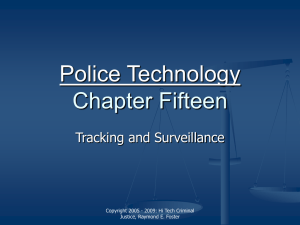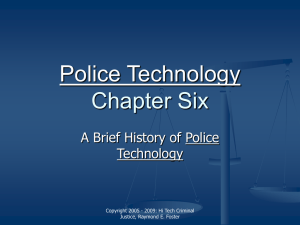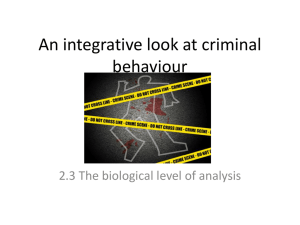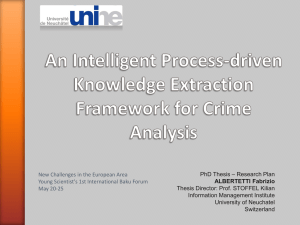Chapter Twelve - Crime Analysis - Hi Tech Criminal Justice online
advertisement
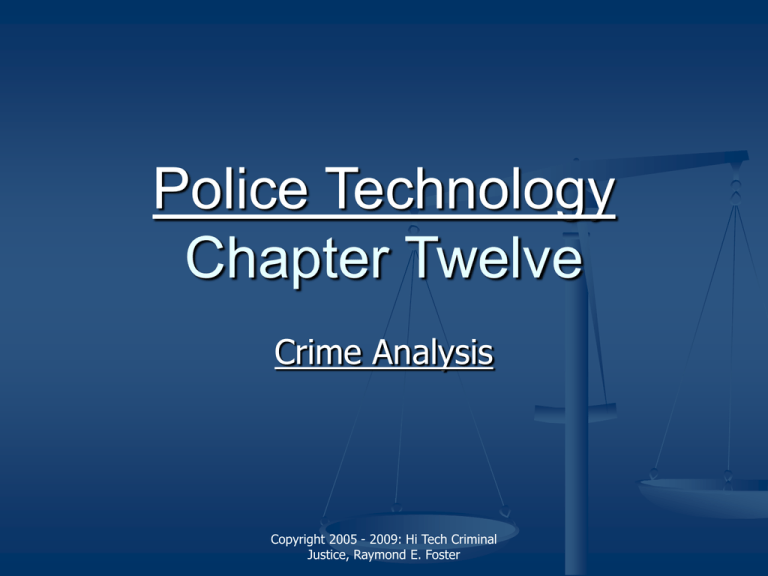
Police Technology Chapter Twelve Crime Analysis Copyright 2005 - 2009: Hi Tech Criminal Justice, Raymond E. Foster Learning Objectives Understand the definition of Crime Analysis and underpinning theories Understand the applications of Crime Analysis Be exposed to how Crime Analysis can be used to solve community problems and advanced crime mapping topics Copyright 2005 - 2009: Hi Tech Criminal Justice, Raymond E. Foster Introduction Without the component of criminal investigations, neither the Community Policing nor Problem-Oriented Policing models have value. Copyright 2005 - 2009: Hi Tech Criminal Justice, Raymond E. Foster Introduction At the core, the functions of state and local law enforcement remain: Prevention Investigation, and Apprehension Copyright 2005 - 2009: Hi Tech Criminal Justice, Raymond E. Foster Crime Analysis and Community-Oriented Policing Problem solving is a critical component of the COP model. An essential part of problem solving is an examination of incidents, their relationships to each other, and their relationships to underlying problems. Copyright 2005 - 2009: Hi Tech Criminal Justice, Raymond E. Foster Crime Analysis One of the ways police officers use their expertise in problem solving is through the analysis of crime. Crime Analysis starts with crime mapping. A crime may be the result of a variety of other factors. Copyright 2005 - 2009: Hi Tech Criminal Justice, Raymond E. Foster Crime Analysis Crime mapping is about: Problem solving The identification of the problem Using the information gained from analysis to mitigate the problem Copyright 2005 - 2009: Hi Tech Criminal Justice, Raymond E. Foster SARA Scanning-Analysis-Response-Assessment: One of the most prevalent problem-solving methodologies used by police departments Copyright 2005 - 2009: Hi Tech Criminal Justice, Raymond E. Foster What Are the Benefits of Crime Analysis? The ability to show relationships between crime and casual factors. Promotes information integration and cooperation among different police agencies and other government agencies Copyright 2005 - 2009: Hi Tech Criminal Justice, Raymond E. Foster Crime Analysis and COP A COP enhancer because they can assist in the establishment of partnerships with other non-law enforcement agencies. Can enhance communication within and without the police department. Copyright 2005 - 2009: Hi Tech Criminal Justice, Raymond E. Foster Time, Space and Crime These relationship factors may be: Spatial in nature (resulting from its proximity to a location). Temporal – Having to do with a certain time period Copyright 2005 - 2009: Hi Tech Criminal Justice, Raymond E. Foster Displacement Crime Analysis information is used to deploy more officers in an area that is experiencing a higher crime rate. The deployment of more officers stops the crime form occurring there and then – It is displaced. Displacement can be spatial or temporal. Copyright 2005 - 2009: Hi Tech Criminal Justice, Raymond E. Foster Incapacitation Most crime is committed by a very small percentage of a community. The police should be targeting their efforts on those individuals If an offender is arrested instead of being displaced, incapacitation occurs. Copyright 2005 - 2009: Hi Tech Criminal Justice, Raymond E. Foster Serial Crimes Multiple crimes committed by an offender or group of offenders, which occur over a period of time. Crime Analysis is moving towards the identification of serial crimes and the targeting of serial offenders Copyright 2005 - 2009: Hi Tech Criminal Justice, Raymond E. Foster Rational Choice, Situational Crime Prevention, and Crime Analysis Situational Crime Prevention is based on two things: Offender opportunity and Rational Choice Theory Copyright 2005 - 2009: Hi Tech Criminal Justice, Raymond E. Foster Offender opportunity Offenders choose to commit crimes when: The opportunity is right They have enough information that the value of the crime is more than the risk of punishment (risk vs. value) Copyright 2005 - 2009: Hi Tech Criminal Justice, Raymond E. Foster Routine Activity Theory Three parts to this theory: An offender A victim The absence of an interfering or restraining force – something that adds to the risk of detection. Copyright 2005 - 2009: Hi Tech Criminal Justice, Raymond E. Foster The Basic Requirements for Crime Analysis You cannot conduct modern crime analysis without mapping capabilities You cannot conduct geographic and statistical analysis without minimal hardware and software Copyright 2005 - 2009: Hi Tech Criminal Justice, Raymond E. Foster At minimum you need . . . A laptop or desktop computer with sufficient speed Hard disk storage to accommodate your data and functions A high-quality printer that can handle color maps and workload. Copyright 2005 - 2009: Hi Tech Criminal Justice, Raymond E. Foster Where does the data come from? Two types of data needed: Mapping data – general data about your community Crime data – specific data about criminal occurrences in your community Copyright 2005 - 2009: Hi Tech Criminal Justice, Raymond E. Foster The Analysis of a Crime Crime Analysis begins with statistical analysis. Mapping is critical to Crime Analysis, but it is not the starting point. Copyright 2005 - 2009: Hi Tech Criminal Justice, Raymond E. Foster Burglaries 2003/4 Jan 82 Feb 78 Mar 75 Mean number April 74 the average May 75 June 80 July 72 993 / 12 = 82 Aug 75 Sept 78 Oct 80 Nov 110 Dec 114 Copyright 2005 - 2009: Hi Tech Criminal 993 Justice, Raymond E. Foster The Analysis of a Crime Begins with look at average occurrences as compared to another period. This can indicate a rise in crime. After initial statistical analysis that indicates a rise, the search for patterns begins. A search for patterns – time, date, method of operation, etc, can lead to potential solutions Copyright 2005 - 2009: Hi Tech Criminal Justice, Raymond E. Foster Hot Spots An area that traditionally has a lot of crime or An area with an unusual increase in crime Copyright 2005 - 2009: Hi Tech Criminal Justice, Raymond E. Foster Forecasting The use of mathematical models to predict the next likely occurrence Copyright 2005 - 2009: Hi Tech Criminal Justice, Raymond E. Foster Forecasting Attempting to predict future events by using past events as a guide. Temporal analysis is the most common type of forecasting Spatial analysis is less common Copyright 2005 - 2009: Hi Tech Criminal Justice, Raymond E. Foster Crime Analysis and Problems A problem is a cluster of incidents. The relationship of the problem to space and time may provide information about the solution. Perhaps causation like driving under the influence arrests and the location of locations that sell alcoholic beverages Perhaps causation like the presence of an active offender Copyright 2005 - 2009: Hi Tech Criminal Justice, Raymond E. Foster Geographic Profiling Used with serial crimes (typically the most serious crimes) Used to determine offender’s geographic attributes (where they might live, work, and socialize). Copyright 2005 - 2009: Hi Tech Criminal Justice, Raymond E. Foster Geographic Profiling Takes the attributes of time, space, behavior, target, and offender and analyzes their spatial and temporal information in order to determine an offender’s activity space (the hunting area). Copyright 2005 - 2009: Hi Tech Criminal Justice, Raymond E. Foster Police Technology Learn more about Civil Service at www.lapdauthors.com/civil-service-exam Copyright 2005 - 2009: Hi Tech Criminal Justice, Raymond E. Foster


